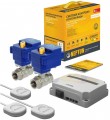Main system components supplied in the kit.
The finished delivery kit includes three components: a control unit (CU), a leakage sensor(s) and a special ball valve(s). At the same time, both
control units(including those
built into the valve) and
valves can be sold completely separately. Let's take a closer look at each component:
- Control unit. The “brain” of the system, is directly responsible for its functioning: it receives signals from sensors and controls the valves. In this case, we mean a control unit made in the form of a separate device. Installing such a system is somewhat more complicated than in the case of a valve with a built-in control unit — it is necessary to ensure that the control unit is connected not only to the sensors but also to the valve(s). On the other hand, the control module can be placed in a convenient place. In addition, this kind of arrangement is optimal if you need to shut off several points in the water supply system at once: one common external unit for several valves, as a rule, is cheaper than several valves with built-in control units.
—
Cvalves with control unit. A control unit built directly into the ball valve is responsible for shutting off the water. This design makes it possible to reduce the dimensions of the system and
...the total number of components in it, and, as a result, significantly simplifies installation. On the other hand, a built-in control unit is usually responsible only for its own valve and does not allow the connection of additional ones. So it makes sense to pay attention to this option mainly in three cases: either if you need to cover only one point, if compactness and a minimum number of components are crucial, or if there are difficulties with installing a remote control unit.
— Ball valve. A special valve driven by an electric motor shuts off the water supply based on a signal from the control unit. Note that the kit usually includes a small number of valves — no more than 3, while control units can support a larger number. This is done so that the customer does not overpay for extra valves when purchasing a set. If the standard equipment is not enough, additional valves can be purchased separately.
— Leakage sensor. A sensor that reacts to contact with water. When water gets on the touch surface, such a sensor sends a signal to the central unit, reporting a leak. Note that many systems allow the connection of more sensors than are supplied in the kit. The sensors themselves can use both wired and wireless connections to the control unit; some kits support both options at once. See “Sensor connection” for details.
